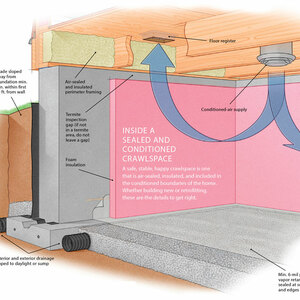On a television show a while back I watched a contractor install a precast basement stairwell up against a poured concrete wall. To mate the seams, the contractor used a butyl-rubber sealant that had the consistency of putty and was dark ash-gray or black. I’ve seen similar stuff used to fill the seams in sectionalized poured concrete floors in commercial spaces.
Considering how a lot of bay window metal roof caps are installed against brick facades in my neck of the woods, and the potential for shoddy installation resulting in leakage (I’m living proof of this bad condition), why isn’t a similar or same sealant used on the backside of the metal roof cap’s lip (the section of the metal cap that actually comes into contact with the brick) to insure a water-tight condition?
The builder’s original contractor used a ‘something’ but it was so sparingly used as to find no evidence at this point. During the first 2-3 years in this new construction home the builder had his Neanderthal painter use painter’s caulk to reseal to no end as it failed a year later.
Currently, I have an ad in the Help Wanted section with no replies. I went to ServiceMagic and the only person that replied tried to use something that looks like that same butyl-rubber sealant, but the SOB cap is still leaking after being addressed twice by the current hire.
So, after 18-months, two contractors, and several attempts to resolve my leaking bay window I am at a loss on how to proceed. If I know someone with a tank I’d have them take shots at my house (can’t leak any worse than it is now). The room that has this bay window hasn’t been used in 18-months and based on the efforts and results thus far I doubt it will ever be used again.
Ideas, suggestions, or just burn the house down?



















Replies
Considering how a lot of bay window metal roof caps are installed against brick facades in my neck of the woods, and the potential for shoddy installation resulting in leakage (I'm living proof of this bad condition), why isn't a similar or same sealant used on the backside of the metal roof cap's lip (the section of the metal cap that actually comes into contact with the brick) to insure a water-tight condition?
Are you saying they aren't flashed at the brick/roof intersection?
If so, you're screwed. You have likely spent enough already to have had riglets cut in the brick and proper step and counter flashing installed.
If you have a picture, I'll bet CU and piffen will give you a detail fix, without the use of a "magic sealent".
Dave
I'll get and post an up-close picture tomorrow.
I wondered the same thing. I have a Superior Walls basement & they use something similar to seal between the wall sections.
That seems to common in your area.
A year or some ago some one had a similar problem.
And they had torn out the bay ceiling and other interior.
The problem might not be at bay roof to brick.
Rather, in her case, it appears that water was getting in higher in the wall and running down the back of the brick.
And brick is like that.
We had a problem with water getting into a bay window on the first floor. The brick to roof over the bay was flashed properly. The bay was only on the first and did not continue up to the second floor roof line. The problem was that the brick above was letting water through when the rain blew into it. The builders solution was to seal the brick above the bay. The solution worked for 10 years until the house was sold.
Actually if it was flashed properly the flashing would go behind the brick and there would be weep holes to allow the water behind the brick to get out.http://www.copper.org/applications/architecture/arch_dhb/flashings_copings/wall_flashing.html
Great instructional site.
Thanks,
Bruce
There is also a Brick Institution (or maybe it is Association) that also has lots of informtion on brick detailing such as this.
Bill, actually the water was coming from two distinct locations: cornice return at the roof-2nd floor ceiling location (repaired, I hope) and the metal bay window cap. I actually posted about this >year ago. I thought I was going to get help from a neighbor (contractor), but repeated and undelivered promises, plus Winter, etc. only served to delay until I moved onto another contractor.
Last Monday it rained hard enough for water to get in, but I had no evidence it came from the cornice return this time (thankfully), but this metal cap is pitiful. If it were not for the condition of not finding matching brick I would remove the bay window altogether, even though it runs to the floor in elevation.
Sorry
Through wall flashing would have helped but it's a little late for that now. That said, copper counter flashing above a bay window should be 'let in" to the brick mortar joints. This counter flashing is installed over the base flashing. A similar detail that is used where a brick chimney intersects a roof.
Look for posts from SeeYou (sp?) or Sphere as this is what they do for a living - metal roofing.
I'll go searching for those posts. This will have to be something I do, because while the two contractors I've spoken to thus far have agreed it would be the 'extreme' solution in my case, neither one seems to want to tackle that kind of job--maybe they are only looking for the quick buck jobs.
Installing let in flashings is not rocket science, nor is it extreme.
I wasn't suggesting it was rocket science. :) But to local contractors, it is beyond their abilities or desires.
Another vote for base flashing and let in counterflashing. Caulk and sealants are the glue for flashing. Only flashing is flashing.
Not hard at all to let in flashing. Angle grinder with small diameter diamond blade and a joint or plug chisel.
View Image
"A job well done is its own reward. Now would you prefer to make the final payment by cash, check or Master Card?"
I think I have found a coupe of subdivisions still under construction where they are flashing the correct way. Maybe a can find the subcontractor they are using and get them to do a bit of retail work. I really do not need yet another chore on my honey dew list.
BTW, how often are you gonna find a homeowner willing to write a blank check and find no contractor willing to take on the chore? I live in the land of caulkers--skills not required.
Sphere's planning a road trip. Quite a detour, but maybe you could bribe him.
Just don't delay him so long he misses here.
Sometimes it's DIY or do w/o. Least my life tends to work that way.
PAHS Designer/Builder- Bury it!
To address the title of your thread...
Look at the attached pic. I forget what you call the stuff, but that is what is used to seal the connection between 2 pieces of RCP, or manhole precast pieices - the invert and the cone or spacer ring. It's not going to help your situation though. the stuff is not terribly sticky, and relies more on the mass of the 2 pieces of precast concrete to keep the gasket material in compression and to create a seal.
Superior Walls, the precast panel concrete basement wall system, uses a urethane caulk between panels, which they claim is a 50 year product, but again, I doubt that it would help your situation.
Yep, that is it, the butyl-rubber sealer. I think today I will go sub-hunting. No, not nuclear submarine, but subcontractor. I know of a couple of under-construction communities around me where they have bay windows. I'll ask a builder for a subcontractor name/number and run with it.
My only concern now is that the last contractor put something on the metal-lip & brick that he said wouldn't come off.